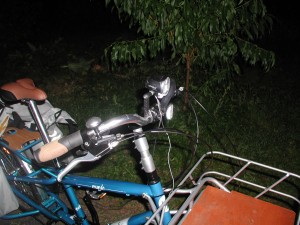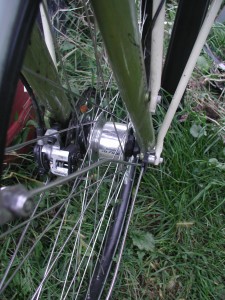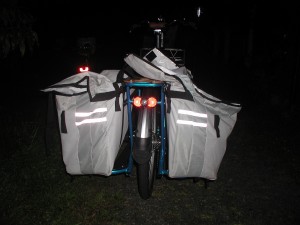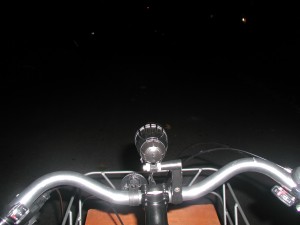 To be able to safely use your bike at all times of the day, you need to be able to see and be visible.
To be able to safely use your bike at all times of the day, you need to be able to see and be visible.
Being visible is from the back for passing cars, from the side in intersections, as well as from the front, for cars turning onto the road you are traveling on, from a side street or driveway. The trickiest one is the last case, as that is the only case where the car’s light doesn’t shine at you, so passive light reflectors will not do the job.
If you do night riding anywhere else but downtown where the roads are already lit up, you need a front light anyway, so that solves the frontal visibility. And in my opinion the front light is the only challenging part of the equation. Passive reflectors are cheap, and many bikes come with them on the front, end, in the spokes and on the pedals. A battery powered back light is cheap and the LED ones are strong enough to be easily visible yet long lasting, so I carry at least two of them on me just to not have to worry about the batteries running out leaving me in the dark. But the front light is harder, because it needs to be very bright and that takes power, even in the case of an LED bulb.
 The system I have grown to like over the years for bicycle lighting has a hub-generator in the front wheel hub, so again, batteries are not a concern, a Busch&Muller head light, and a non-battery rear light (in my case also Busch&Muller, so they work very well together, but the type is less important as long as it is an LED light). In particular, look at the Lumotec IQ CYO.
The system I have grown to like over the years for bicycle lighting has a hub-generator in the front wheel hub, so again, batteries are not a concern, a Busch&Muller head light, and a non-battery rear light (in my case also Busch&Muller, so they work very well together, but the type is less important as long as it is an LED light). In particular, look at the Lumotec IQ CYO.
This light has a few unique features, so it doesn’t look any more like a flashlight converted to be bike-mountable. It is LED, which means, that it is able to convert the available energy to an extremely bright light, even though it only has the 3 watts from the hub generator to use – or more exactly 2.7 watts, so the rear light has a share of 0.3 watts too, if it is connected.
It has a directed beam, which means all the light ends up where you need it, on the road in front of you, and will not blind and aggravate others by shining into their eyes. Don’t worry these head lights have plenty of light so they are still visible.
 The “Senso” version senses whether it is day or night, and can automatically turn off or adjust the beam to the most appropriate setting. It also handles the rear light, if connected, so that also works automatically.
The “Senso” version senses whether it is day or night, and can automatically turn off or adjust the beam to the most appropriate setting. It also handles the rear light, if connected, so that also works automatically.
The “Plus” version can stay on for a few minutes even if the bike stops, thus the electricity from the hub stops, so you remain visible while you wait to cross an intersection.
The “T” version not only makes sure that you see the road during the night, but that you are well visible during the daytime, by using a few extra LED’s that throw their light everywhere, but only during the day.
 This whole set (back light, Front light and hub dynamo) is between $230 to $330, because the front hub will have to have the wheel around it. Luckily for us living in the US Peter White Cycles sells all these German-made lights, including battery powered versions, in which case the cost is closer to $100 to $150, but you are stuck recharging the 4 AA batteries after every 5 hours of use or so.
This whole set (back light, Front light and hub dynamo) is between $230 to $330, because the front hub will have to have the wheel around it. Luckily for us living in the US Peter White Cycles sells all these German-made lights, including battery powered versions, in which case the cost is closer to $100 to $150, but you are stuck recharging the 4 AA batteries after every 5 hours of use or so.

One Response to Lighting Your Bike